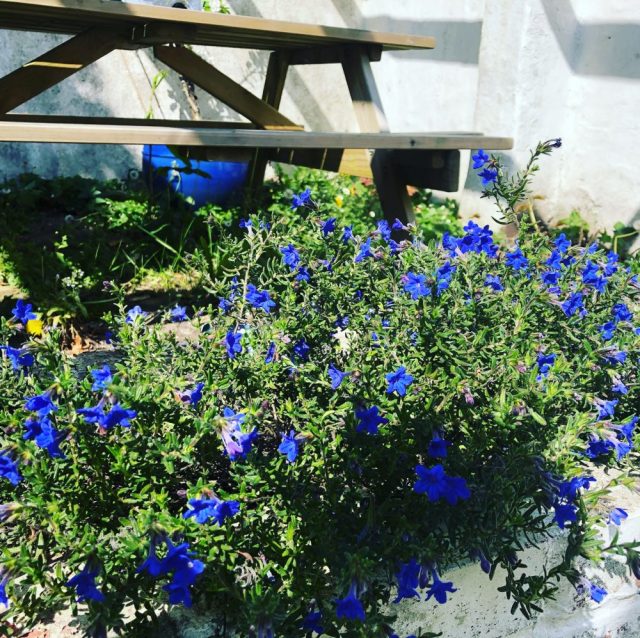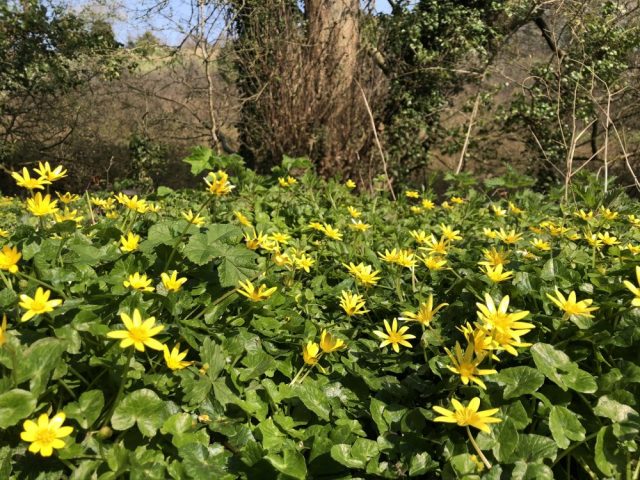I inspected my two hives for the first time this year recently. The weather in Cornwall has been gorgeous since lockdown began, so I was expecting to find some brood and honey, maybe even brood boxes bursting with bees. Sadly, though both colonies are still alive, neither seems to have a queen.
I inspected Demelza without needing my smoker; her bees remain as gentle as ever. They had stores, and plenty of foragers returning, but no sign of any eggs or brood. No chaotic cells containing the multiple eggs of laying workers yet either. Just lots of empty cells in the middle of the brood nest where brood should be. It’s unusual for queenless hives to be good tempered, but something isn’t right.
Kensa’s bees were a very different and more nerve wracking matter, needing heavy smoking. I would have been stung from head to toe if they could have reached me! I couldn’t blame them for being mardy though, as they were low on stores and only had a couple of frames of capped brood. I spotted no eggs. I didn’t see the queen in either hive, though I was deliberately focusing on trying to find eggs rather than the queen. Kensa’s queen is presumably quite flighty as I’ve always found her hard to hunt down.
I don’t think I can do much to help either colony. They’re not in a state to start a Bailey comb change as I had hoped. Ideally I would get another queen from somewhere but it’s probably too early in the season for that, especially with everything going on at the moment. I’ve set up a bait hive in case I can catch an early swarm. For now I will just use dummy boards to reduce the amount of space in the hives and feed Kensa’s hive syrup. They were battered by a winter of rain and storms, which perhaps was too much for them. With baby Holly around I haven’t had as much time to focus on them as I’d like. Guess what though… the chimney bees are still alive!
I’ve been enjoying seeing the spring flowers come out in my garden and in the couple of local parks I can reach on foot. Below are some pics.
Below is Lithodora – a favourite with the little black local female Hairy footed flower bees. I think they nest in my neighbour’s wall, as I have seen them coming and going around there.
These cheery yellow flowers are lesser celandine, which grows at the edges of fields, hedgerows and in woodland.
Cherry tree in my garden. The petals fall constantly, producing beautiful confetti. Our mini apple trees have come through the winter well and are attracting pollinators with their freshly scented white blossom.





Might they have swarmed?
LikeLike
Hi Jen, I really doubt it. I haven’t heard of any colonies swarming round here yet. My in laws have a large garden and when my hives have swarmed in the past they’ve landed in the garden first. They’ve only had about 3 weeks to start recovering from the non stop rain and hail storms we had in Cornwall up till about March. It literally rained nearly every day this winter and often not just any rain but absolutely torrential rain and howling winds.
LikeLiked by 1 person
Ohh in that case she has maybe just had a break from laying? Been a tough winter on them…
LikeLike
Maybe, perhaps she’s gone on a permanent strike!
LikeLiked by 1 person
Haha! Well I hope things improve so she can get back to laying ☺️
LikeLike
Interesting. I’m in a similar situation with one of my hives.
Bit troubled by your first picture above. Would it be rhododendron by any chance. Google ‘Mad Honey’ …… “Mad honey, is a type of honey that is actually a poison. It is a neurotoxin that could cause hallucinations and get you stoned, even in small amounts.”
LikeLiked by 1 person
Good luck Paul. After talking to more experienced beekeepers, I’m starting to wonder whether they are really queenless at all. The good tempered one may have a virgin queen in there and the bad tempered one may have stopped laying temporarily due to lack of forage coming in. Really need a test frame of eggs from somewhere to be sure though.
We do have a lot of rhododendrons in Cornwall, but I don’t think that one is the R.ponticum species that creates wild honey. I looked into mad honey for a blog post a few years ago – https://adventuresinbeeland.com/2016/03/18/are-rhododendrons-toxic-to-bees/ – it gets quite complicated as honey bees here usually avoid visiting it, it’s the honey bees in countries where the r.ponticum originally came from, like Turkey and Nepal, that makes the ‘mad honey’.
LikeLike
To be sure, I “liked” the weather and flowers, not what appears to be not-so-good news about the hives.
LikeLike
Thanks Emilio! Sorry I haven’t been commenting much on your blog lately. Tommy’s nursery shut so I have a lot less spare time to read/sit down!
LikeLike
No worries. I don’t expect anyone to cater to my ginormous ego; it’s self-sustaining.
LikeLike
Hello Emily, nice to hear from you once again! How I miss your cake descriptions…
Not sure where you are in the spring process but no eggs is one of the signs of imminent swarming as well…as they diet the queen and run her about getting her light enough to fly, she stops laying. Did you see any drone brood? That usually caps out first, then they run the queen around to get her ready.
LikeLike
And I miss eating the cakes! I still make them now and again but have to bake gluten free for my son nowadays, it’s not as easy.
We’re not there yet with the swarming, I expect first swarms in Cornwall will be end of April. No drone brood. These colonies are really struggling unfortunately, they’re not in a state to attempt swarming.
LikeLike
How about a frame of eggs as broom from a fellow beekeeper?
Sent from my iPhone
>
LikeLike
That would be ideal but think it would be a big ask at the moment with social distancing going on.
LikeLike
That Lithodora is a gorgeous blue! I hope the Queen situation is not as bleak as it looks, or you can easily sort it.
LikeLike
Thank you! Hopefully the bees may sort it themselves.
LikeLiked by 1 person
Thank you!
LikeLiked by 1 person
It sounds like Demelza might have a queen, perhaps still virgin or immature. The bees are so sneaky. We put a super on a hive, just frames-no foundation, to see if we could get some comb honey. The hive swarmed a few days later leaving a little honey comb. Cutting the honey comb out we noticed a few cells with larvae. That is impossible if you use a queen divider isn’t it? These bees are generally small and black and I think one sneaky, young slim new queen has sneaked up to the super to lay. We find it very difficult to see the queens just now. We had a lovely large yellow one who was much easier to see than the totally black ones. Amelia
LikeLike
I think you may be right about a virgin queen being in there Amelia. I need to get in again and have a second look. That sneaky queen in your super! I’ve also heard that sometimes the workers move eggs up into the supers, but beekeepers seem to disagree on that. Very difficult to catch them at it presumably!
LikeLike
Demelza might have superseded, and the queen could have been out on a maiden flight. I find when the bees make empty cells ready there is often a queen in the works. Maybe next weekend you’ll find a surprise. I hope so!
Take care.
LikeLike
A nice selection of color there. Are you sure about your hives being queenless? I can’t remember the last time I saw either one of my queens. If everything else seems ok, might not need to worry or take action just yet…
LikeLike
Thanks – it’s more the lack of eggs and uncapped brood which is worrying me rather than not seeing the queens. Last weekend I got some eggs from a local beekeeper so am going to see if they make queen cells from that.
LikeLiked by 1 person
Good luck!
LikeLike